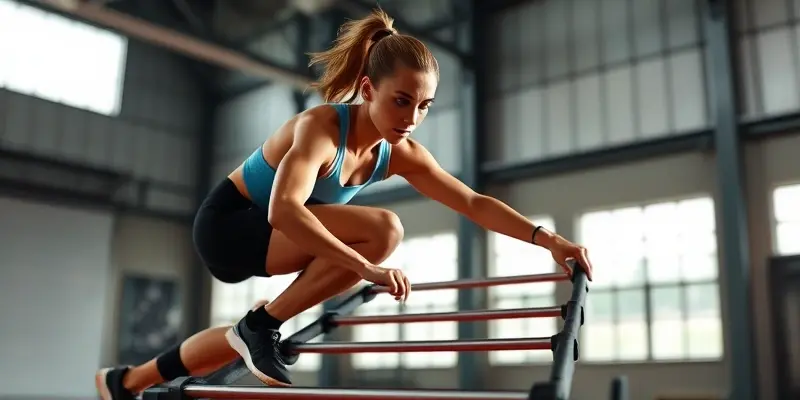Injury can sideline even the most dedicated athlete or gym-goer. But what if a simple training tool could dramatically lower your risk and help you bounce back faster? Enter the agility ladder—an underrated, science-backed way to boost recovery and keep injuries at bay. Whether you’re a beginner, a seasoned athlete, or simply aiming for a healthier, more agile body, this guide is for you.
What Are Agility Ladder Routines—and Why Do They Matter?
Agility ladder routines are structured exercises performed on a flat ladder laid out on the ground. Picture stepping, hopping, or shuffling your way along its squares. While it may sound simple, these drills challenge your coordination, balance, and speed. But there’s more: research shows that agility work trains your nervous system to react swiftly and safely, improving neuromuscular control and movement mechanics.
These routines aren’t reserved for elite athletes. Anyone—whether you’re chasing a tennis ball or racing your kids—can benefit from better balance, quick footwork, and injury resilience.
How Agility Ladders Help Prevent Common Injuries
Let’s face it: most sports injuries, such as ankle sprains and muscle strains, happen during sudden changes in direction or unexpected movements. Agility ladder drills replicate these situations in a safe, controlled way, teaching your body how to respond without getting hurt.
Think of it like “software updates” for your muscles and joints:
- Ankle sprains occur during awkward side movements; lateral shuffles on the ladder reinforce stability.
- Hamstring and calf strains often result from explosive starts; basic hopping and stepping routines teach controlled acceleration.
Expert tips to prevent injuries:
- Start simple and focus on controlled, quality movement—speed comes later.
- Consistency trumps intensity. Regular practice (2–3 times a week) is more effective than the occasional long workout.
- Progress gradually, only introducing advanced drills when you feel confident with the basics.
Beginner-Friendly Agility Ladder Exercises
Ready to give it a try? Here are five drills anyone can start today—no fancy gym membership required:
- Single Foot In Each Square: Step one foot at a time through the ladder. Focus on a light touch and steady rhythm.
- Two-Foot Run: Quickly place both feet in each square before moving on. Maintain posture and avoid heavy stomping.
- In-and-Outs: Begin with feet outside the ladder, step in and out laterally. Builds hip and ankle flexibility.
- Lateral Shuffle: Move sideways along the ladder, keeping your knees bent and chest up to protect from ankle rolls.
- Forward Straddle Hop: Hop both feet in and out of the squares. Land softly and keep your core engaged.
Common mistakes to avoid: rushing through drills, skipping the warm-up, or losing focus on form. Remember, quality always beats quantity.
Recovery & Nutrition for Agility Athletes
Recovering from an injury? Agility ladders can speed up your rehabilitation—if used wisely.
- Active recovery: Start with basic drills (think: Single Foot or Two-Foot Run) to restore joint mobility and confidence.
- Progress slowly: Only introduce more complex patterns as you regain strength and balance.
- Consult your physio or coach if you’re returning from a major injury—personalized guidance is crucial.
Your recovery isn’t just about movement—nutrition matters too:
- Protein-rich foods (lean meats, tofu, legumes) repair muscle tissue after exercise.
- Omega-3-rich foods (salmon, chia seeds) and antioxidants (antioxidants in sports nutrition) (berries, leafy greens) curb inflammation and promote healing.
- Stay hydrated to keep muscles and joints supple.
Tools and Mindset: The Next Level
Great recovery and injury prevention go beyond drills. Try these tools and strategies:
- Foam rollers and massage balls for muscle tension relief post-exercise.
- Compression gear may support circulation, especially during travel or after tough sessions.
- Balance boards and resistance bands enhance proprioception—think of it as “GPS for your body.”
Mindset matters too:
- Set small, achievable agility goals to maintain motivation.
- Use visualization: picture yourself performing drills confidently—science shows it helps reinforce healthy movement patterns. Learn more about visualization for healing.
Conclusion
Agility ladder routines offer a powerful, accessible way to improve your athletic performance, prevent injuries, and speed up recovery—no matter your fitness level. Start slow, focus on quality, and build your routine thoughtfully. With the right approach, you’ll feel stronger, more balanced, and better prepared for anything life or sport throws your way.
Have questions or want to share your progress? Join the conversation with the GymPulse community—together, we’ll keep you moving safely and confidently!

